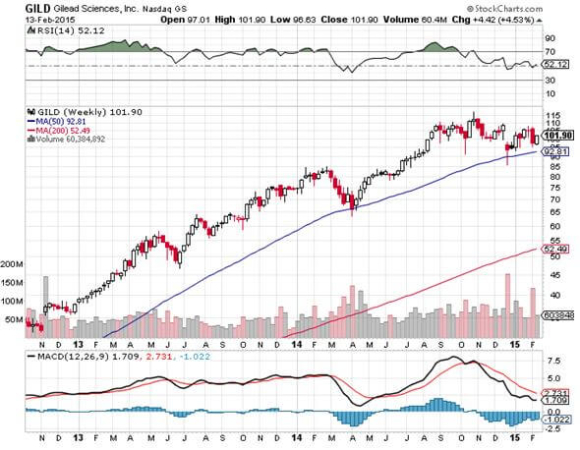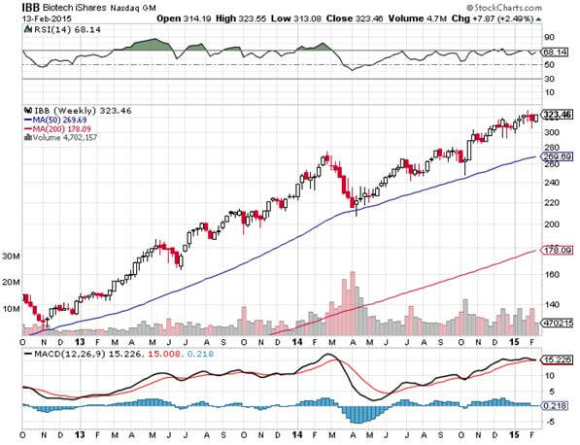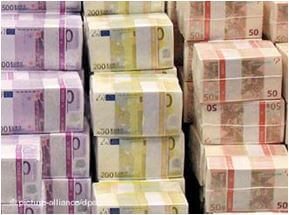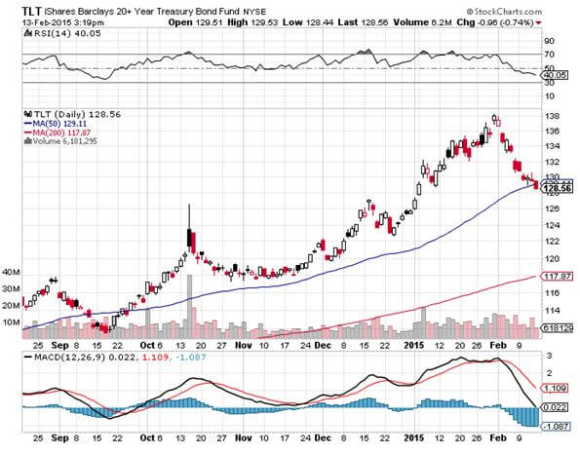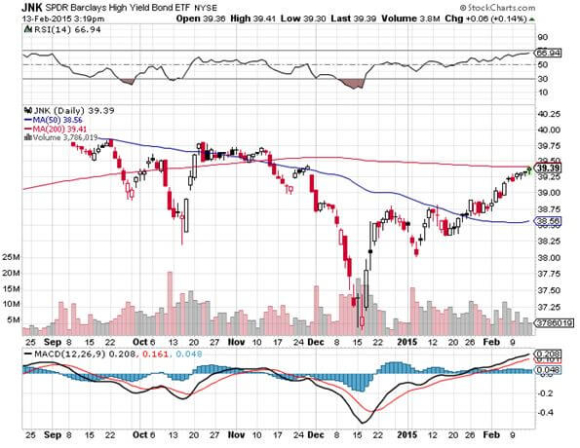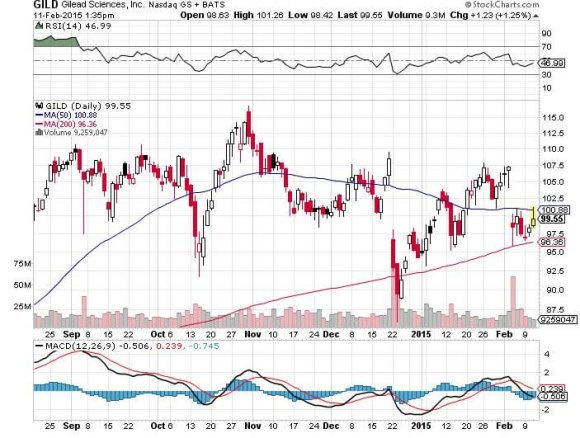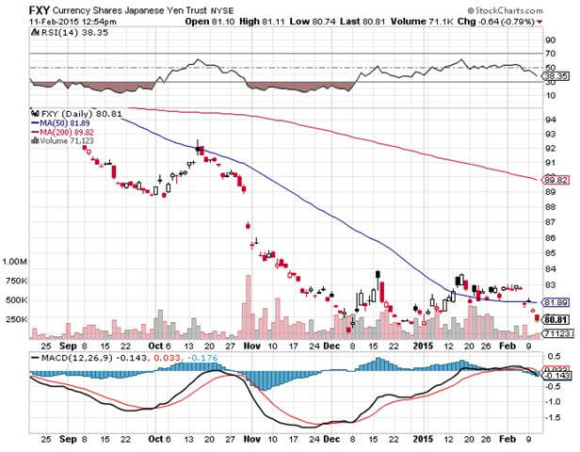Global Market Comments
February 18, 2015
Fiat Lux
Featured Trade:
(AN AFTERNOON WITH GENERAL COLIN POWEL)
Global Market Comments
February 17, 2015
Fiat Lux
Featured Trade:
(FRIDAY, APRIL 3 HONOLULU, HAWAII STRATEGY LUNCHEON),
(HOW FAR WILL BIOTECH RUN?),
(GILD), (IBB)
Gilead Sciences Inc. (GILD)
iShares Nasdaq Biotechnology (IBB)
Long-term readers of this letter have prospered mightily from my addiction to biotech stocks in recent years, one of the most reliably top performing sectors in the stock market.
But have we visited the well one time too many times? Is biotech turning into a bubble that will eventually deliver the same grievous outcome of other past bubbles?
Not yet.
Still, one has to ask the question. No less a figure than Federal Reserve governor Janet Yellen has indicated that she thought valuations in the biotech sector were getting ?substantially stretched.? The Fed doesn?t single out stocks for commentary very often.
Biotech certainly has been a money-spinner for followers of my top performing Trade Alert service, which delivered a 30.5% profit in 2014.
Readers made three round trips in hepatitis C drug developer Gilead Sciences (GILD) in the past four months, adding 5.77% to the value of their portfolios. I believe the company?s blockbuster drug will become the most profitable in history. So do a lot of others.
Longer-term investors bought the Biotech iShares ETF (IBB) on my advice, which gained an impressive 45% last year, and is still rising.
However, biotech has long been a hedge fund favorite.
That means many shareholders are only dating these stocks and are not married to them. The hot money regularly flows in and out, giving the sector more than double the volatility of the main market. A 10% correction in any other stock is worth at least 25% in biotech.
This also makes biotech stocks great to buy on a dip. My last foray into (GILD) occurred after cautious guidance took the shares down a heart stopping 10% in a single day.
This is a great example of how unusually sensitive biotech stocks are to headline risk. I?ve ridden stocks to tremendous heights, watching them pour billions into a single treatment, only to see them crash and burn on failed stage three trials.
That is just the nature of their business. It?s all about all or nothing bets.
It?s just a matter of time before one of the major companies gets stuck with a hickey like this, flushing billions down the drain. That could herald a generalized sector selloff that could last months, or even years.
Biotech is a high-risk sector that should only be held within a well diversified portfolio. You may notice that in the Mad Hedge Fund Trader?s model trading portfolio I never have more than 10% in biotech at any given time. I figure I could handle a total blow up and lose the whole 10% and still stay in business.
When I speak at conferences, strategy luncheons and on TV, I tell listeners of my lazy man?s guide to long-term investment. Only follow three sectors, technology, biotech and energy, and ignore the other 97. You?ll save yourself a lot of time reading pointless research.
Biotech currently accounts for a mere 1% of US GDP. It is on its way to 20%, about where technology is today. That means that a disproportionately large share of earnings growth will spring from biotech over the coming decades.
One way to protect yourself is to stick with the big caps, which are undervalued relative to the sector, and are expected to haul in 20% earnings growth this year.
Many smaller companies prices are assuming a total certainty of the success of their drugs. The reality is that this only happens about half the time.
If you do go with small caps, I would take a venture capital approach. Buy a dozen with the expectation that many will go under, a couple do OK, and one goes through the roof. Never put all your eggs in one basket.
It also helps that you have someone with a scientific background making your picks, like me. Because drug companies promise such amazing results, like curing cancer, the sector has always been prone to hype and over promotion. I never met I biotech CEO who didn?t believe his company was about to deliver the next panacea, taking his shares up tenfold.
One plus for biotech is that it has unusually strong patent protection, which usually extends out 20 years for new products. There are not a lot of Chinese companies that can imitate their drugs.
That means earnings can be predicted far into the future, and are largely immune from the economic cycle. If you?re sick, you want to get cured regardless of whether the GDP is growing or shrinking, or whether interest rates are low or high.
Make sure that your investments have plenty of new developments in the pipeline. Expiring patents on past winners with no replacements can spell certain death for a stock price.
Publicly listed drug companies are now venturing into research fields that were only science fiction when I was in the lab 45 years go. ?Gene editing? whereby genes can be repaired, edited and then turned on and off at will, is now becoming a burgeoning new science.
It promises to cure the whole range of human maladies, including heart disease, cancer, obesity and a whole range of degenerative diseases (including some of mine).
Expect to hear a lot more about TALENs (transcription activator-like effector nucleases) and CRISPR (clustered regular interspaced short palindromic repeats). You heard it here first.
What is truly fascinating is that hybrid computer science/biochemical scientists are now taking algorithms developed y the National Security Agency hackers and using them to decode human DNA. (I hope I?m not speaking too much out of school here.)
Gene editing is the natural outcome of the discovery of recombinant DNA technology developed during the 1970?s by Paul Berg, Herbert Boyer, and Stanley Cohen, all early heroes of mine.
Since none were the equity participants of private companies, the initial rewards for the breakthrough were minimal. I remember that one received a new surfboard for his efforts.
Berg went on to found Genentech (GENE) in 1977 and got rich. If I hadn?t gone into the stock market, that is almost certainly where I would have ended up.
How things have changed.
The short answer here is that biotech does have further to run. A lot further.
The rate of innovation of biotechnology is accelerating so fast that it will continue to spew out fantastic investment opportunities for the rest of your lives. So expect to receive many more Trade Alerts in this area in the years to come.
But it is definitely an ?E? ticket ride. So fasten your seatbelt on your path to riches.
As for me, I?m thrilled that I got to live so long to see this stuff happen. At times, it was a close run race.
 This One Looks Like a Winner
This One Looks Like a Winner
Global Market Comments
February 16, 2015
Fiat Lux
Featured Trade:
(FEBRUARY 18 GLOBAL STRATEGY WEBINAR),
(WHY ARE BOND YIELDS SO LOW?)
(TLT), (TBT), (LQD), (MUB), (LINE), (ELD),
(QQQ), (UUP), (EEM), (DBA)
(BRING BACK THE UPTICK RULE!)
iShares 20+ Year Treasury Bond (TLT)
ProShares UltraShort 20+ Year Treasury (TBT)
iShares iBoxx $ Invst Grade Crp Bond (LQD)
iShares National AMT-Free Muni Bond (MUB)
Linn Energy, LLC (LINE)
WisdomTree Emerging Markets Lcl Dbt ETF (ELD)
PowerShares QQQ Trust, Series 1 (QQQ)
PowerShares DB US Dollar Bullish ETF (UUP)
iShares MSCI Emerging Markets (EEM)
PowerShares DB Agriculture ETF (DBA)
Investors around the world have been confused, befuddled and surprised by the persistent, ultra low level of long term interest rates in the United States.
At today?s close, the 30 year Treasury bond yielded a parsimonious 2.01%, the ten year, 2.62%, and the five year only 1.51%. The ten-year was threatening its all time low yield of 1.37% only two weeks ago, a return as rare as a dodo bird, last seen in August, 2012.
What?s more, yields across the entire fixed income spectrum have been plumbing new lows. Corporate bonds (LQD) have been fetching only 3.29%, tax-free municipal bonds (MUB) 2.89%, and junk (JNK) a pittance at 5.96%.
Spreads over Treasuries are approaching new all time lows. The spread for junk over of ten year Treasuries is now below an amazing 3.00%, a heady number not seen since the 2007 bubble top. ?Covenant light? in borrower terms is making a big comeback.
Are investors being rewarded for taking on the debt of companies that are on the edge of bankruptcy, a tiny 3.3% premium? I think not.
It is a global trend.
German bunds are now paying holders 0.35%, and JGB?s are at an eye popping 0.30%. The worst quality southern European paper has delivered the biggest rallies this year. Portuguese government paper is paying only 2.40%, and is rapidly closing in on US government yields.
Yikes!
These numbers indicate that there is a massive global capital glut. There is too much money chasing too few low risk investments everywhere. Has the world suddenly become risk averse? Is inflation gone forever? Will deflation become a permanent aspect of our investing lives? Does the reach for yield know no bounds?
It wasn?t supposed to be like this.
Almost to a man, hedge fund managers everywhere were unloading debt instruments in January. They were looking for a year of rising interest rates (TLT), accelerating stock prices (QQQ), falling commodities (DBA), and dying emerging markets (EEM). Surging capital inflows were supposed to prompt the dollar (UUP) to take off like a rocket.
It all ended up being almost a perfect mirror image portfolio of what actually transpired since then. As a result, almost all mutual funds are down so far in 2014. Many hedge fund managers are tearing their hair out, suffering their worst year in recent memory.
What is wrong with this picture?
Interest rates like these are hinting that the global economy is about to endure a serious nose dive, possibly even re-entering recession territory?or it isn?t.
To understand why not, we have to delve into deep structural issues, which are changing the nature of the debt markets beyond all recognition. This is not your father?s bond market.
I?ll start with what I call the ?1% effect.?
Rich people are different than you and I. Once they finally make their billions, they quickly evolve from being risk takers into wealth preservers. They don?t invest in start-ups, take fliers on stock tips, invest in the flavor of the day, or create jobs. In fact, many abandon shares completely, retreating to the safety of coupon clipping.
The problem for the rest of us is that this capital stagnates. It goes into the bond market where it stays forever. These people never sell, thus avoiding capital gains taxes and capturing a future step up in the cost basis whenever a spouse dies. Only the interest payments are taxable and that at a lowly 20% rate.
This is the lesson I learned from servicing generations of Rothschild?s, Du Ponts, Rockefellers, and Getty. Extremely wealthy families stay that way by becoming extremely conservative investors. Those that don?t, you?ve never heard of, because they all eventually went broke.
This didn?t used to mean much before 1980, back when the wealthy only owned 10% of the bond market, except to financial historians and private wealth specialists, of which I am one. Now they own a whopping 23%, and their behavior affects everyone.
Who has bee the largest buyer of Treasury bonds for the last 30 years? Foreign central banks and other governmental entities, which count them among their country?s foreign exchange reserves. They own 36% of our national debt, with China in the lead at 8% (the Bush tax cut that was borrowed), and Japan close behind with 7% (the Reagan tax cut that was borrowed). These days they purchase about 50% of every Treasury auction.
They never sell either, unless there is some kind of foreign exchange or balance of payments crisis, which is rare. If anything, these holdings are still growing.
Who else has been soaking up bonds, deaf to repeated cries that prices are about to plunge? The Federal Reserve, which thanks to QE1, 2, and 3, now owns 22% of our $17 trillion debt. Both the former Federal Reserve governor Ben Bernanke, and the present one, Janet Yellen, have made clear they have no plans to sell these bonds. They will run them to maturity instead, minimizing the market impact.
An assortment of other government entities possess a further 29% of US government bonds, first and foremost the Social Security Administration, with a 16% holding. And they ain?t selling either, baby.
So what you have here is the overwhelming majority of Treasury bond owners with no intention to sell. Only hedge funds have been selling this year, and they have already done so, in spades.
Which sets up a frightening possibility for them, now that we are at the very bottom of the past year?s range in yields. What happens if bond yields fall further? It will set off the mother of all short covering squeezes and could take ten-year yield down to match the 2012, 2.38% low.
Fasten your seat belts, batten the hatches, and down the Dramamine!
There are a few other reasons why rates will stay at subterranean levels for some time. If hyper accelerating technology keeps cutting costs for the rest of the century, deflation basically never goes away (click here?for ?Peeking into the Future with Ray Kurzweil?).
Hyper accelerating corporate profits will also create a global cash glut, further levitating bond prices. Companies are becoming so profitable they are throwing off more cash then they can reasonably use or pay out.
This is why these gigantic corporate cash hoards are piling up in Europe in tax free jurisdictions, now over $2 trillion. Is the US heading for Japanese style yields, or 0.39% for 10 year Treasuries?
If so, bonds are a steal here at 2.55%. If we really do enter a period of long term -2% a year deflation, that means the purchasing power of a dollar increases by 35% every decade in real terms.
The threat of a second Cold War is keeping the flight to safety bid alive, and keeping the bull market for bonds percolating. This could put a floor under bond prices for another decade, and Vladimir Putin?s current presidential run could last all the way under 2014.
All of this is why I?m out of the bond market for now, and will remain so for a while.
 Why Are They So Low?
Why Are They So Low?
Global Market Comments
February 13, 2015
Fiat Lux
Featured Trade:
(FEBRUARY 18 GLOBAL STRATEGY WEBINAR),
(THE CASE FOR EUROPE),
(FXE), (HEDJ), (RSX), (GREK), (GLD), (TLT), (SPY)
(OPTIONS FOR THE BEGINNER)
CurrencyShares Euro ETF (FXE)
WisdomTree Europe Hedged Equity ETF (HEDJ)
Market Vectors Russia ETF (RSX)
Global X FTSE Greece 20 ETF (GREK)
SPDR Gold Shares (GLD)
iShares 20+ Year Treasury Bond (TLT)
SPDR S&P 500 ETF (SPY)
Global Market Comments
February 12, 2015
Fiat Lux
Featured Trade:
(HITTING TWO HOME RUNS IN ONE DAY),
(FXY), (GILD),
(THE NEW COLD WAR),
(THE HISTORY OF TECHNOLOGY)
CurrencyShares Japanese Yen ETF (FXY)
Gilead Sciences Inc. (GILD)
Those of you who are paid subscribers have the good fortune of waking up to a bounty of riches this morning.
Both Gilead Sciences (GILD) and the Japanese yen (FXY) have made gap moves in your favor overnight. Your long position in (GILD) saw a nice little $2 pop to the upside, and your short in the (FXY) just got whacked in the knees, down a full $1.
As a result, the Trade Alert model-trading portfolio is now up +4% on the year. It?s not exactly knocking the ball out of the park, but should be enough to keep you in fine Chardonnay for the rest of the year. And compared to most other suffering, money losing hedge fund traders, it is more than adequate.
If you followed my advice, your existing positions in these two securities are now close to their maximum expiration value. However, as is so often the case with deep in the money options with only days to expiration, they have become highly illiquid.
For example, the February (FXY) $87 puts are trading at $6.00-$6.90 on the screen, against an intrinsic value of $6.22 ($87 - $80.78 in the cash market = $6.22). So a market order to sell would most likely wipe out your entire profit.
So I am going to run my positions into expiration, given that we only have six trading days to go. These are my last two positions, so I also have an excess of dormant, unused cash.
I am trying to maintain some discipline here and restrict myself to only buying low and selling high. I know this sounds revolutionary, but it should work. Like you, I am not paid according to the volume of Trade Alerts I issue, only on their end results.
However, this market has shown a pronounced tendency to Giveth, and then abruptly Taketh Away. So, if you don?t want to wait until next week to collect your winnings and free up margin, you can put in some high limit orders to sell.
The Gilead Sciences (GILD) February, 2015 $35-$37 in-the-money bear put spread has an intrinsic value here of $5.00, so you can probably get a $4.95 offer done.
The Currency Shares Japanese Yen Trust (FXY) February, 2015 $84-$87 in-the-money vertical bear put spread has an intrinsic of $3.00, so $2.97 probably gets executed. If it doesn?t just re-enter the order tomorrow and try again, or lower your limit by a penny.
Congratulations, and on to the next one.
For me that is going to be an opportunistic short term long position in the S&P 500 (SPY) February 20 expiring options.
It?s rare to see an options spread with only six trading days to expiration offering so much money. But with the Volatility Index (VIX) holding in at a lofty 17.70%, we can take in a nearly 2% profit with a near strike that is a full 2% out of the money.
That means the S&P 500 (SPY) has to drop a hefty $4.60 by Friday next week for you to lose money on this position.
I know that?s not impossible in this uncertain environment. But I think that we are in nothing more than a long, sideways correction in a major long-term major uptrend, so this should work.
Traders are confused and disoriented, thanks to the massive one-way moves in oil and bonds in recent months. Many long tested models have blown up.
So rather than continue to hemorrhage money, they are giving up. The large intraday moves and sky-high volatility may continue. But I don?t expect any large sustainable net moves in the near future.
You are going to have to be especially vigilant with your stop loss on this (SPY) position, which I shall put at $202, as there is so little time left to expiration.
The 50 day moving average at $204 should give us plenty of support on the downside, and enough time to make it to expiration and get out whole.
Since this is a big contract and fairly close to the money, there should be plenty of liquidity right up to the last day, if we have to stop out.
 Time for another Dose of Gilead Sciences
Time for another Dose of Gilead Sciences
 It?s All Over for the Yen
It?s All Over for the Yen
Legal Disclaimer
There is a very high degree of risk involved in trading. Past results are not indicative of future returns. MadHedgeFundTrader.com and all individuals affiliated with this site assume no responsibilities for your trading and investment results. The indicators, strategies, columns, articles and all other features are for educational purposes only and should not be construed as investment advice. Information for futures trading observations are obtained from sources believed to be reliable, but we do not warrant its completeness or accuracy, or warrant any results from the use of the information. Your use of the trading observations is entirely at your own risk and it is your sole responsibility to evaluate the accuracy, completeness and usefulness of the information. You must assess the risk of any trade with your broker and make your own independent decisions regarding any securities mentioned herein. Affiliates of MadHedgeFundTrader.com may have a position or effect transactions in the securities described herein (or options thereon) and/or otherwise employ trading strategies that may be consistent or inconsistent with the provided strategies.



